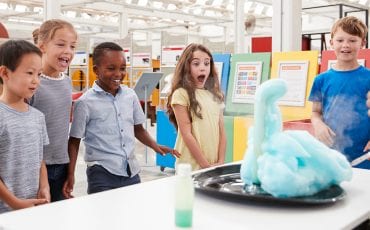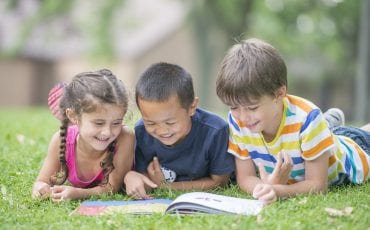Montessori Myths Busted
If you peek inside a Montessori classroom, what will you see? Children busy and engaged in self-directed learning. Montessori education values fostering children’s natural desire to learn. The Montessori method of education dates back to 1907 and was developed by Italian physician Maria Montessori. Despite its long history, you might have some misconceptions about this educational approach.
Table of Contents
Myth #1: The school day isn’t structured.
A day at a Montessori school begins with an uninterrupted work cycle, which may range from one hour to three hours, depending on the age group. Students peruse the classroom for activities to complete lessons.
“The parallel in a different environment would be that the time is broken into adult-oriented activities: ‘We’re doing art now; Now, we’re reading,’” says Cara Friedline, the Toddler/Primary Division Head at Springmont School. “In Montessori, we have those things going on at the same time, as each child chooses what to do.”
Students are allowed playtime outdoors, time as a group and a break for a snack and lunch. After lunch, younger children will nap, while older students complete a second work cycle.
“The work cycle gives children the opportunity to work on lessons they’ve already received or to receive new lessons. Dr. Montessori knew uninterrupted time was important for children to get into their work and accomplish tasks,” says Kathryn O’Neill, the Toddler & Primary Coordinator at Arbor Montessori School.
At the middle school level, students begin with skills classes, working to master different subjects, such as foreign language or math. Lessons might include teachers, sometimes called guides, who specialize in those areas of study. In the afternoon, they complete integrated project studies, such as a biology unit in the garden.
Myth #2: The Montessori classroom is chaotic.
Since Montessori education is self-directed, you might expect a wild classroom atmosphere. Instead, students work in an organized and efficient manner on independent lessons. Dr. Montessori created learning materials that are still used today, and students use those to complete lessons.
Students learn the expectations of the classroom and practice the rules. They learn to respect the environment and the materials, returning items to the appropriate shelf and cleaning up after themselves.
“We’re giving you experience with making choices, when you want to start and when you want to finish. With older kids, we do expect that they’ll complete their work,” says Gina Ward, the Director at Carlisle Montessori School. “It’s a peaceful environment, and students treat each other with grace and courtesy.”
Adhering to classroom rules may require a learning curve. “They’re not expected to be perfect, but they’re practicing,” Ward adds. “And once they accomplish these practical experiences, they’re so proud.”
Myth #3: There is too much freedom in the classroom.
Montessori education is a child-focused approach encouraging self-motivated growth. As such, Montessori approaches focus on independence; however, students learn to adhere to the expectations.
“It’s a self-regulated environment. They get to choose what they are going to do first and what they’re going to do next,” says Bhairavi Chandramouli, Montessori Academy at Sharon Springs’ School Leader. But students are not allowed complete control of the classroom. “If a child is wandering around the classroom wondering what to do next, the teacher knows his work plan and can help him. We give them the freedom to pick what they want, which helps them become decision makers.”
Because the Montessori classroom caters specifically to the student and her age group, the child is allowed more freedom.
“Montessori is a triangle between the child, the adult and the environment. The environment is prepared to answer every one of their needs,” Friedline says. “There’s nothing that’s not for them, in contrast to the child’s home environment, where they’re sharing space with parents, grandparents, older siblings. It’s an environment where we get to say ‘yes’ a lot: ‘Yes, you may try that; yes, you may take that off the shelf.’ It allows the child to be self-directed.”
As children age into elementary and adolescent programs, this balance of responsibility and freedom continues.
“We offer choices for one to choose how to use the time and day. If the rules are not respected, then the freedom can be limited by the teacher choosing appropriate or challenging works for the student,” says Kellie Mosel, the Adolescent Math & Science Guide at Carolyn Barron Montessori School.
Myth #4: Mixed age groups push the kids too quickly.
In Montessori education, instead of grouping kids by grades, students are placed in mixed age classrooms corresponding to their plane of development.
“The misconception with age groups is that they’re being stretched prematurely, or they’re asked to do something they’re not ready for yet,” Friedline says.
Younger children observe what older students are learning, so they know what’s expected of them when they move up, and older children can serve as mentors.
“One of the most beautiful elements of Montessori are the age groups working together,” Chandramouli says. “The older ones lead the classroom. They can guide and support the younger ones. It’s a moment of pride for them when they get to help.”
Myth #5: They’re not learning anything.
“Because education doesn’t look the way it did for most people, they can have a hard time seeing how we’re working — the kids are having too much fun, they can’t be learning,” says David Tyler, Arbor Montessori School’s Adolescent Program Coordinator. “Teachers connect them to learning in a meaningful and joyful way.”
As part of Arbor’s adolescent program, students participate in a miniature economy where they run their own businesses, teaching them economic independence, business management, how to spend money responsibly and more.
“They’re learning extensively. Behind the scenes, we double check they are meeting the standards they’re supposed to,” Tyler says. “Once they reach middle school, we have more traditional means of evaluation with homework and tests. The driving mission is preparation for the real world, which is the reality of the educational climate at the majority of schools our students will go into.”
Because students learn on their own time, they can spend as much time as they need to with a subject.
“One of the key concepts of Montessori is scientific exploration. Students get to explore deeply with the work,” Friedline says. “They learn 6 times 4 is the same as 8 times 3, and they become owners of that discovery, rather than something someone tells them they need to know.”
Myth #6: The lessons are just busy work.
Projects allow students to dive into subjects that are interesting to them, allowing them to feel excited about learning and their work. Projects are often the culmination of skills, resulting in a final product of which they are proud.
Lessons also build upon future subjects. When Chandramouli taught the periodic table, she asked her students to organize their own interests into groups similar to the periodic table. “One student grouped cars; one used Pokémon cards. They’re associating their learning with an interest. In middle and high school, when the teacher shows the students the periodic table, they won’t find it scary. They’ve already been exposed to it and developed a familiarity with it.”
Independent projects become more important as students age. “We try very hard to let them take the lead, as much as they can,” Tyler says. “We allow students to select what they want to be working on. Most students can handle more autonomy than they’re given credit for. Some students propose whole units or courses of study we didn’t anticipate. Some ideas don’t lead to success, but we don’t want them to be so afraid of failure they don’t try things. Even if it didn’t work out the way they intended, the process of trying is just as important.”
Teachers are available when students need adult guidance, but they are given more responsibility than in a traditional classroom. “We go on a four-night trip at the end of the year, and students plan the entire trip. Renting a car, booking flight tickets, budgeting for meals and figuring out where to stay are all their responsibility,” Mosel says.
Myth #7: Montessori programs are only for young children.
Some Montessori schools have programs that continue into adolescence, such as Arbor Montessori School and Carolyn Barron Montessori School. Montessori education follows children’s planes of development. This is why younger children explore subjects using tactile materials and older children phase out of that tradition as they naturally transition to abstract learning.
“At this level, students are the age to learn abstractly, and there are less of the physical materials required for lessons,” Mosel says. “Many discussions begin to occur regarding current events, social issues and in-depth conversations about lessons. There are some physical materials, like the fraction set or maps. We build upon those materials seen early on in the primary and elementary classrooms.”
Myth #8: Grades are necessary to assess progress.
Most Montessori programs, particularly for younger ages, don’t include graded tests or projects. Instead, parents observe classes to see how their kids are thriving. When issues arise, parents are called in for a conference.
“We want everybody to be on the same page: ‘We’ve noticed so-and-so is only interested in painting, but we also need to focus on these skills.’ We might give them an idea for what they can do or not do at home,” O’Neill says. “If parents emphasize academic work at home, children may not want to do it at school. We make sure we’re all working for the best interest of the child.”
Schoolwork will depend on the child’s age and ability.
“We focus on the quality of the work rather than the quantity,” says Mosel. “We work with our students to set deadlines for assignments and projects. Some students may have a different due date than others based on circumstances or abilities. The classroom is not a ‘one size fits all’ curriculum.”
Myth #9: Transitioning to traditional schools will be difficult.
Carlisle Montessori School enrolls students ages 1-5 years. “Parents think because students are not producing work sheets, when they graduate, they’re not going to have a sense of order,” Ward says. “Our kids go to first grade programs in both public and private schools and excel. Over and over, I hear from local school directors that they love Montessori kids — they’re responsible and mature, adaptable and smart.”
The smaller environment allows teachers to guide students in cultivating real-world skills.
“We teach them conflict resolution. If we address these moments at the right time, they learn how to navigate relationships,” Chandramouli says. Montessori Academy at Sharon Springs has programs for ages 13 months-12 years. “Middle school is a tricky phase of life, but in most cases, Montessori children have such high self-awareness, they can navigate when they’re in awkward social scenarios and can self-regulate.”
Arbor Montessori School’s adolescent program helps students find the next stop in their educational journey. “We put students in touch with our alumni. When they’re ready to leave here, we can find the best next fit for them and their families,” Tyler says.











